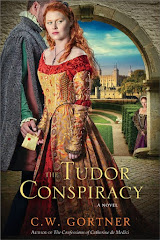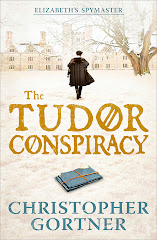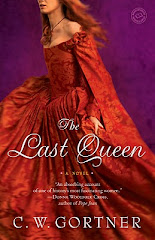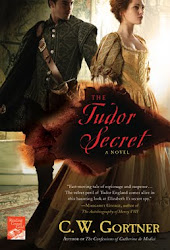 One of the highlights of 2008 for me was reading an advance copy of Robin Maxwell's SIGNORA DA VINCI, set in 15th century Italy. Robin's books have thrilled me for years; whether she's exploring the life of Anne Boleyn, the youth of Elizabeth I or the Irish tragedy of Elizabeth's later reign, her work is distinguished by painstaking scholarship, a true passion for the era, and dramatic characterizations. When I first got SIGNORA DA VINCI , I was excited, as everything I'd read of Robin's thus far was set in the Tudor period. I was also honored because Robin herself had asked me to give the book an endorsement, which says it all:
One of the highlights of 2008 for me was reading an advance copy of Robin Maxwell's SIGNORA DA VINCI, set in 15th century Italy. Robin's books have thrilled me for years; whether she's exploring the life of Anne Boleyn, the youth of Elizabeth I or the Irish tragedy of Elizabeth's later reign, her work is distinguished by painstaking scholarship, a true passion for the era, and dramatic characterizations. When I first got SIGNORA DA VINCI , I was excited, as everything I'd read of Robin's thus far was set in the Tudor period. I was also honored because Robin herself had asked me to give the book an endorsement, which says it all:"Maxwell tells the story of Caterina, an alchemist's daughter whose illicit love affair brings her the greatest love of her life, her genius son Leonardo da Vinci. In order to watch over and protect him, she escapes the restrictions of her gender, entering into a seductive garden of philosophy, art, and learning. From the dusty streets of Vinci and the glories of Il Magnifico's Florence, to the conspiratorial halls of Rome and Milan, Signora da Vinci celebrates one woman's unquenchable ardor for knowledge, and a secret world that readers rarely see."
I am honored to present this guest post from my friend, Robin Maxwell, in celebration of the publication of what I personally consider her best book to date, the fabulous and unputdownable SIGNORA DA VINCI.
I know I’m not alone in my utter fascination for the ridiculously fertile mind and staggering accomplishments of the original “Renaissance Man”— Leonardo da Vinci. But studying his works revealed only a fraction of the intimate, character-driven story I knew I wanted to tell in Signora da Vinci. Who was this person? What was he like as a child? Most of all: where did he acquire his earth shattering genius? The more I dug, the clearer it became. There was simply no way that he’d inherited his gifts from his social-climbing, icy-hearted, petty bureaucrat of a father. They had to have come from his mother.

The problem, I discovered, was that next to nothing is known of Caterina da Vinci, save her name and this cluster of facts: Leonardo’s father refused to marry her, and the infant was snatched from Caterina’s arms the day after his birth, thereafter raised in the loveless home of his paternal grandfather. Somehow, the dearth of information about “the most important woman we’ve never heard of,” sparked a fire in my mind. The city of Florence, at the very moment that Leonardo was sent there to learn his trade as an artist, was the center of the intellectual, cultural and political universe. The brightest stars of philosophy, science, art, architecture, music and international finance came together and out of the ashes of Medieval Europe built the foundation of the Renaissance movement.
Bound and determined to take these intriguing puzzle pieces and create a compelling novel, I concocted a device that allowed Caterina to follow her young son into the city —and to my great delight — to insinuate herself into the innermost circles of Florentine society. I disguised her as a man. Suddenly I possessed, through Caterina, the best of both worlds for an author of fiction— a character that was able to view her son Leonardo’s glorious and sometimes scandalous career through a woman’s eyes, while gaining entrée into intellectual circles — Lorenzo de’ Medici’s secret and heretical “Platonic Academy” — normally reserved for men.
For me, the Italian Renaissance was not simply an explosion of the art and architecture that most people think of when they hear the words. What my research uncovered was a “Shadow Renaissance” steeped in Platonic and Hermetic philosophy and Egyptian magic. Almost every ruler, writer, scientist or thinker in those years at least toyed with alchemy and the occult. Despite the church’s prohibitions, most of these great men (and a few women) took these views very seriously indeed. Few admitted to being outright atheists like Leonardo, but attempting to meld Christian scripture with the pagan mysteries was extremely common, especially in educated and highly cultured circles…even in Rome.
Despite its importance, one finds little if anything written about the Platonic Academy and its impact on the early Italian Renaissance -- as though it was a men’s social club and not an overarching philosophy that informed the lives of its members, making them especially vulnerable when the Dominican friar, Savonarola, came to power. Authors – both fiction and non-fiction – tend to ignore the implications of such towering figures as Lorenzo de Medici – one of the greatest patrons of the Academy – adhering to such heretical beliefs. But this was, in fact, the foundation of the revolution in thinking that brought Europe out of the dark ages and into the light of the Renaissance.
And then there was Leonardo himself. While everyone seems to have extremely strong opinions about the man, no one – biographer or historian – has conclusive evidence about whether Leonardo was straight, gay, bi-sexual or asexual. My best guess is that his sexual preferences changed according to his age, his social setting, and the emotional and political pressures brought to bear upon him. As a young apprentice in Verrocchio’s bottega, Leonardo was surrounded by lots of “pretty boys” who had little or no money to spend on whores, so homosexual behavior was perhaps more a necessity than a choice.
When Leonardo was nineteen, he and three other Florentine youths (two of whom were relatives of the Medici) were arrested by the church’s Officers of Night on a charge of “sodomy.” The infamous trial that ensued proved nothing, and charges were later dropped. Once he was a bit older, there was every reason to think he visited the female, as well as male prostitutes.
It seems clear that the sodomy trial had an effect on Leonardo’s sexuality – putting him off it for a time. The scandal seemed to traumatize the young, exquisitely sensitive young man. Once an outgoing, fancily clad man-about-town, he became quite reclusive and solitary. Later in life, Leonardo appeared asexual. While he adored having beautiful young men surrounding him as apprentices, he was so caught up in the “life of the mind” that sex may have become quite unimportant to him. Some of his writings suggest that he thought the sex act silly, the sex organs repulsive, and the only redeeming qualities the attractive faces of the participants – all that kept the human race from dying out.
But of all the mysteries surrounding Leonardo, the Turin Shroud hoax is the most intriguing. In Signora da Vinci I’ve based my sub-plot on the idea that the relic was not the burial cloth of the savior, but the first photograph in the history of the world, taken by Da Vinci and a small band of conspirators, with Leonardo himself as Jesus.

The problem, I discovered, was that next to nothing is known of Caterina da Vinci, save her name and this cluster of facts: Leonardo’s father refused to marry her, and the infant was snatched from Caterina’s arms the day after his birth, thereafter raised in the loveless home of his paternal grandfather. Somehow, the dearth of information about “the most important woman we’ve never heard of,” sparked a fire in my mind. The city of Florence, at the very moment that Leonardo was sent there to learn his trade as an artist, was the center of the intellectual, cultural and political universe. The brightest stars of philosophy, science, art, architecture, music and international finance came together and out of the ashes of Medieval Europe built the foundation of the Renaissance movement.
Bound and determined to take these intriguing puzzle pieces and create a compelling novel, I concocted a device that allowed Caterina to follow her young son into the city —and to my great delight — to insinuate herself into the innermost circles of Florentine society. I disguised her as a man. Suddenly I possessed, through Caterina, the best of both worlds for an author of fiction— a character that was able to view her son Leonardo’s glorious and sometimes scandalous career through a woman’s eyes, while gaining entrée into intellectual circles — Lorenzo de’ Medici’s secret and heretical “Platonic Academy” — normally reserved for men.
For me, the Italian Renaissance was not simply an explosion of the art and architecture that most people think of when they hear the words. What my research uncovered was a “Shadow Renaissance” steeped in Platonic and Hermetic philosophy and Egyptian magic. Almost every ruler, writer, scientist or thinker in those years at least toyed with alchemy and the occult. Despite the church’s prohibitions, most of these great men (and a few women) took these views very seriously indeed. Few admitted to being outright atheists like Leonardo, but attempting to meld Christian scripture with the pagan mysteries was extremely common, especially in educated and highly cultured circles…even in Rome.
Despite its importance, one finds little if anything written about the Platonic Academy and its impact on the early Italian Renaissance -- as though it was a men’s social club and not an overarching philosophy that informed the lives of its members, making them especially vulnerable when the Dominican friar, Savonarola, came to power. Authors – both fiction and non-fiction – tend to ignore the implications of such towering figures as Lorenzo de Medici – one of the greatest patrons of the Academy – adhering to such heretical beliefs. But this was, in fact, the foundation of the revolution in thinking that brought Europe out of the dark ages and into the light of the Renaissance.
And then there was Leonardo himself. While everyone seems to have extremely strong opinions about the man, no one – biographer or historian – has conclusive evidence about whether Leonardo was straight, gay, bi-sexual or asexual. My best guess is that his sexual preferences changed according to his age, his social setting, and the emotional and political pressures brought to bear upon him. As a young apprentice in Verrocchio’s bottega, Leonardo was surrounded by lots of “pretty boys” who had little or no money to spend on whores, so homosexual behavior was perhaps more a necessity than a choice.
When Leonardo was nineteen, he and three other Florentine youths (two of whom were relatives of the Medici) were arrested by the church’s Officers of Night on a charge of “sodomy.” The infamous trial that ensued proved nothing, and charges were later dropped. Once he was a bit older, there was every reason to think he visited the female, as well as male prostitutes.
It seems clear that the sodomy trial had an effect on Leonardo’s sexuality – putting him off it for a time. The scandal seemed to traumatize the young, exquisitely sensitive young man. Once an outgoing, fancily clad man-about-town, he became quite reclusive and solitary. Later in life, Leonardo appeared asexual. While he adored having beautiful young men surrounding him as apprentices, he was so caught up in the “life of the mind” that sex may have become quite unimportant to him. Some of his writings suggest that he thought the sex act silly, the sex organs repulsive, and the only redeeming qualities the attractive faces of the participants – all that kept the human race from dying out.
But of all the mysteries surrounding Leonardo, the Turin Shroud hoax is the most intriguing. In Signora da Vinci I’ve based my sub-plot on the idea that the relic was not the burial cloth of the savior, but the first photograph in the history of the world, taken by Da Vinci and a small band of conspirators, with Leonardo himself as Jesus.
SIGNORA DA VINCI is available in bookstores everywhere. Please visit Robin at her fun and informative website at http://www.robinmaxwell.com, where you will find more about her work and a special passport to the complex, fascinating world of SIGNORA DA VINCI.
Thank you, Robin, for taking the time to visit Historical Boys. We wish you all the success in the world!











